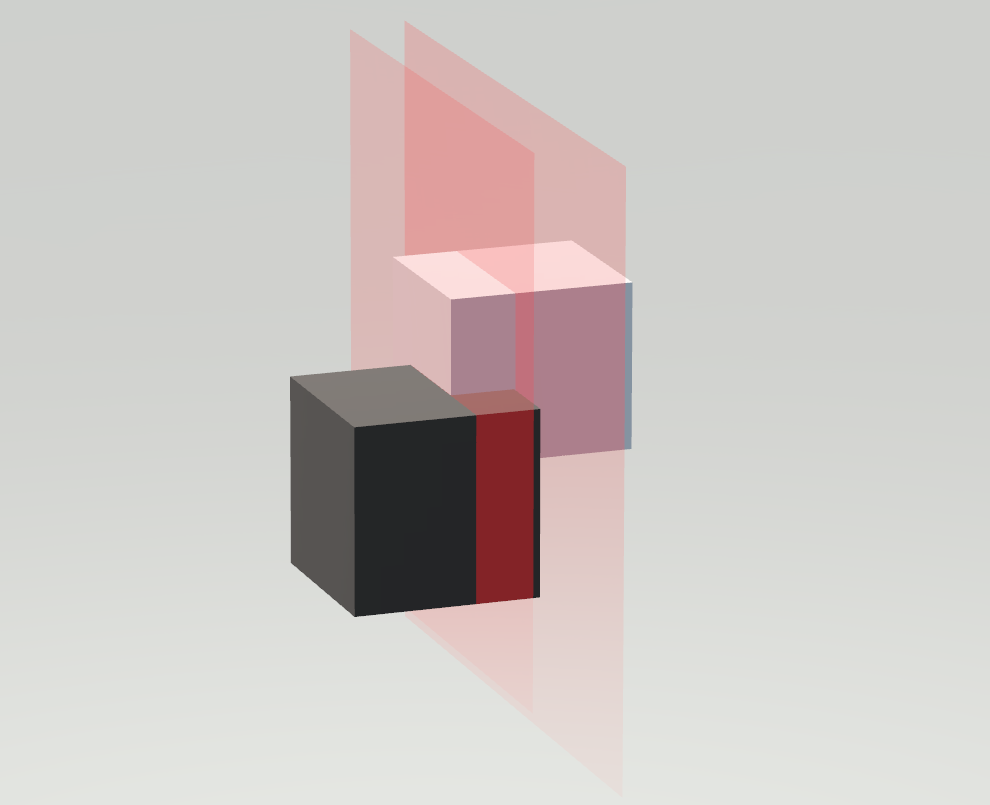bzoj3225 [Sdoi2008]立方体覆盖——扫描线
3225: [Sdoi2008]立方体覆盖
Description
A君近日为准备省队选拔,特意进行了数据结构的专项训练。训练过程中就遇到了“矩形面积并”这道经典问题,即:给出N个各边与坐标轴平行(垂直)的矩形,求矩形覆盖的面积之和。A君按纵坐标建立线段树后按横坐标扫描计算,轻易AC了这道题,时间复杂度为O(NlogN)。
为了强化训练,A君将问题推广到三维空间中,即:给出N个各棱与坐标轴平行(垂直)的立方体,求立方体覆盖的体积之和。为了简化问题,令立方体均退化为正立方体,用四元组(x, y, z, r)表示一个立方体,其中x, y, z为立方体的中心点坐标,r为中心点到立方体各个面的距离(即立方体高的一半)。
这次可难住了A君,只好请你——未来的金牌——来帮助他了。
Input
第一行是一个正整数N。
以下N行每行四个整数x, y, z, r,由空格隔开。
Output
共一个数,即覆盖的总体积。
Sample Input
3 0 0 0 3 1 –1 0 1 19 3 5 6
Sample Output
1944
HINT
对于 100% 的数据,1≤N≤100
对于 100% 的数据,-1000≤x, y, z≤1000,1≤r≤200
思路
看到题目的描述,就很容易想到扫描线,但是扫描线是二维的,这道题是三维的,怎么办?
我们运用扫描线的思想,将这些立方体分隔成为许多的小立方体(如下图)。我们这样就可以每一次计算小立方体就可以了,每一次我们运用扫描线求出众多矩形的面积并,再乘以横向的长度,就可以求出小体积,再将这些小体积相加,就是答案。具体扫描线以及其思想请看:扫描线讲解

代码
#include <cstdio>
#include <algorithm>
using namespace std;
#define N 101
#define inf 1000
int n,cnt,idx,root,ans,tot;
int son[3000<<5][2],times[3000<<5],sum[3000<<5];
struct Surface {int x1,y1,x2,y2,z,kind;}surface[N<<5];
bool cmp1(const Surface &a,const Surface &b) {return a.z<b.z;}
struct Line {int x,y1,y2,kind;}line[N<<1];
bool cmp2(const Line &a,const Line &b) {return a.x<b.x;}
void update(int p,int l,int r)
{(times[p])?sum[p]=r-l+1:sum[p]=sum[son[p][0]]+sum[son[p][1]];}
void change(int &p,int l,int r,int x,int y,int delta)
{
if(!p) p=++cnt;
if(x<=l&&r<=y) {times[p]+=delta,update(p,l,r);return;}
int mid=(l+r)>>1;
if(x<=mid) change(son[p][0],l,mid,x,y,delta);
if(y>mid) change(son[p][1],mid+1,r,x,y,delta);update(p,l,r);
}
int main()
{
scanf("%d",&n);
for(int i=1;i<=n;i++)
{
int a,b,c,d;scanf("%d%d%d%d",&a,&b,&c,&d);
surface[++idx].z=c-d,surface[idx].x1=a-d;
surface[idx].y1=b+d,surface[idx].x2=a+d;
surface[idx].y2=b-d,surface[idx].kind=1;
surface[++idx].z=c+d,surface[idx].x1=a-d;
surface[idx].y1=b+d,surface[idx].x2=a+d;
surface[idx].y2=b-d,surface[idx].kind=-1;
}
sort(surface+1,surface+idx+1,cmp1),surface[idx+1].z=surface[idx].z;
for(int i=1,tmp=0;i<=idx;tmp=0)
{
int area=0;
while(surface[i].z==surface[i+tmp].z&&i+tmp<=idx) tmp++;
for(int j=0;j<tmp;j++)
{
line[++tot].x=surface[j+i].x1,line[tot].y1=surface[j+i].y2;
line[tot].y2=surface[j+i].y1-1;
line[tot].kind=1*surface[i+j].kind;
line[++tot].x=surface[j+i].x2,line[tot].y1=surface[j+i].y2;
line[tot].y2=surface[j+i].y1-1;
line[tot].kind=-1*surface[i+j].kind;
}sort(line+1,line+tot+1,cmp2);
for(int j=1,now=0;j<=tot;j+=now,now=0)
{
area+=sum[root]*(-line[j-1].x+line[j].x);
while(line[j+now].x==line[j].x)
change(root,-inf,inf,line[j+now].y1,line[j+now].y2
,line[j+now].kind),now++;
}i+=tmp;
ans+=area*(surface[i].z-surface[i-1].z);
}
printf("%d",ans);
}

